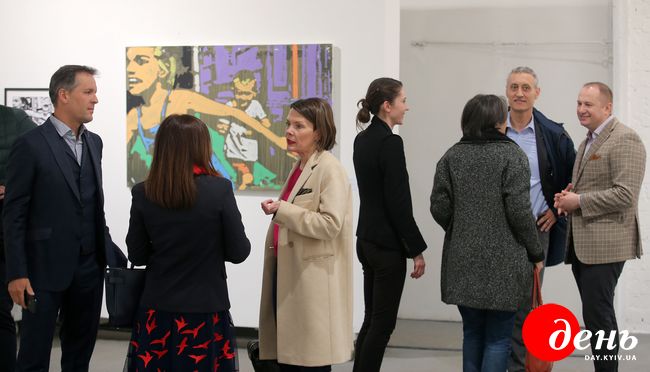“The hand of help” is reaching out to the bride in a white lacey dress… This hand immediately draws your attention on Philippe Bertrand’s black-and-white picture. On Mykola Bilous’ picture, the same theme becomes more abstract – the hand is almost lost against the background of a dress that looks like a flowered tree…
The exhibit “Inversions,” organized as part of the French Spring festival, is now on at Kyiv’s TSEKH gallery. It consists of 13 pairs of works – the pictures of photo artist Philippe Bertrand rhyme with those of Mykola Bilous. The photographs – white-and-black except one – focus on the theme: children are playing the tag, the cape is flying out of a sunbather’s hands, and a cat suddenly appears before the camera’s lens. These details are full of the movement called life. The main thing in Bilous’ pictures is color, the bright flashes of which blur the images. And, for example, the stern policemen (even a party balloon in the hands of one of them does not add lyricism to them) look somewhat more cheerfully in the works of Bilous.
The project spotlights the theme of authorship and authenticity, referring to Roland Barthes’ famous essay “The Death of the Author,” in which the French philosopher argues that writing and creator are unrelated and that the text is “a multi-dimensional space in which a variety of writings, none of them original, blend and clash. The text is a tissue of quotations drawn from the innumerable centers of culture.”
“When a person photographs a sculpture, who is a genius – the photographer or the sculptor? And here photography has been remade into painting. At the same time, the artist has ‘lighted up’ the pictures and ‘switched on’ the color,” says Oleksandr SHCHELUSHCHENKO, founder of the TSEKH gallery and author of the project idea.

Philippe Bertrand has been a self-taught photographer since he was a child. An economist by profession, he works for various international organizations and has often traveled abroad in the past 20 years – to the Caucasus, the Maghreb, Western and Eastern Europe, and the United States. A few weeks before the Euromaidan, he came to Kyiv, where he still lives. In dozens of years, his archives have gathered thousands of pictures, almost all of which are black-and-white.
“I began photographing at 13,” Bertrand recalls. “There was a photo laboratory in our school. We still used film at the time, pictures were developed and printed. When I tried to develop a photo and saw my picture appear on paper, I understood that I would devote all my lifetime to photography. This was a real insight for me. I even had the sensation of a miracle. Then I attended various photography courses. Visiting various exhibits, where I would buy photo albums, also contributed very much to my development. But there always comes a moment when you must stop borrowing from others and begin creating something of your own.”
During the Revolution of Dignity, Bertrand first of all documented the face-off in downtown Kyiv. Now he mostly works in the genre of abstract photography, where he can do his esthetic search, and the results of this are displayed at the exhibit. Although his pictures seem to portray some spontaneously caught moments, the author says his works have become more thought-out in the last while.
Bilous personally chose photographs to be exhibited – he looked through hundreds of Philippe’s works. At first the French photographer was surprised at the artist’s choice, but when he saw the exposition, he grasped its logic. “Most of these pairs show human relationships, and the choice is connected to some extent with this kind of themes,” Bertrand adds. “I can see my works in a new way in this exposition. Mykola allows me to discover something in my own works. And he also discovers himself in a different key.”

PHILIPPE BERTRAND’S “EXPECTATION” TURNS INTO MYKOLA BILOUS’ “MEETING IN A PARK.” THE PHOTOGRAPHER FOCUSES ON THE PLOT, WHEREAS THE ARTIST DOES ON COLOR
Incidentally, it took artist Mykola Bilous some time to dare carry out this experiment. “It was difficult for me to choose photos. But Philippe’s lens can see things very well and interestingly, so I am glad after all that I did it and gained new experience,” the artist says, sharing his impressions. In general, Bilous’ pictures are often based on the stills of films, in which cameramen “cited” paintings.
Sometimes, the pairs of works enter into a dialog even by means of their titles. For example, it is the pictures “Expectation” and “Meeting in a Park” (about dog-lovers who walk out their pets). Karolina Rimkute from the TSEKH gallery also points out opposition between the work and its name on the part of the photographer and the artist. While Bertrand clearly expresses reality but gives an abstract name, Bilous shows, by contrast, a blurred subject and a precise name.
To sum it up, we can see real-life episodes, on the basis of which Bertrand creates a realistic image and Bilous does another one on the basis of pictures, and this collides with the personal vision of spectators. This resembles the “telephone game,” but all the realities are equivalent and self-sufficient, as if they were parallel dimensions.
The exhibit “Inversions” will remain open at the TSEKH gallery until June 1.







